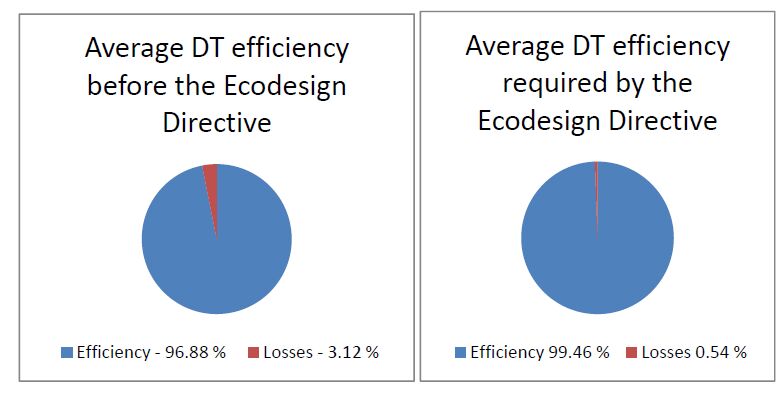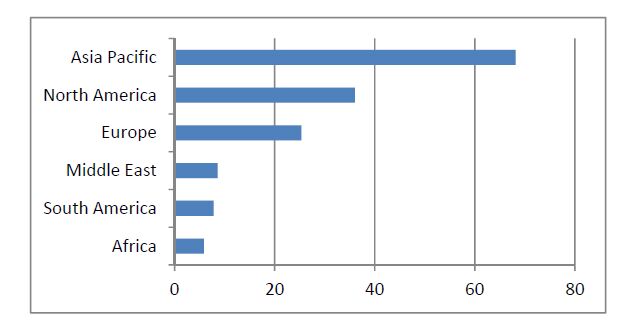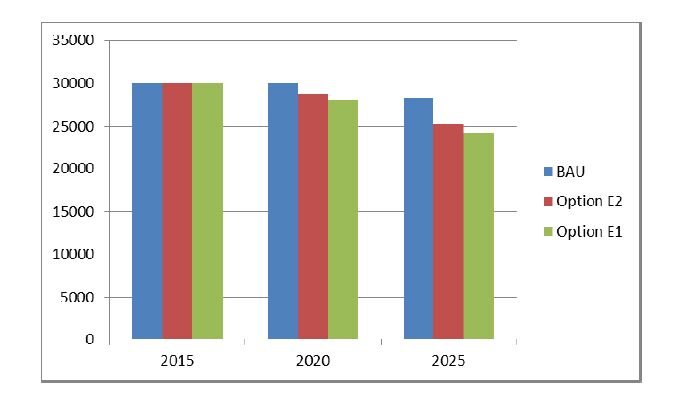Abbreviations
| DT |
Distribution Transformer; |
MEPS Minimum Energy |
Performance Standards; |
| RGO |
Regular Grain Oriented ; |
CRGO |
Cold Rolled Grain Oriented; |
| BAU |
Business As Usual; |
BAT |
Best Available Technology. |
1. Introduction
The electrical grid itself is held responsible for about 9.2% of the global losses in used electrical energy. This number amounts to 1,279 TWh of electrical losses [1]. Even if we take into account that those sizes are largely theoretical and dependent to the country in question (the losses can range from 4% to more than 20%), it can be seen that there are significant possibilities for increasing efficiency. A great percentage of those losses are unavoidable. Distribution lines go on for miles on end, depending on the structure of the grid, and they consist of elements (such as cables) whose electrical efficiency cannot be increased with conventional means. However, the same does not stand true for Distribution Transformers (henceforth called DTs). DTs are responsible for ¼ of the losses of the electrical grid, representing about 2.5% of Europe's energy consumption. Since DTs are a still developing electrical machine, this number can change by increasing their performance. Even with some transformers reaching as high efficiency as 99.5% there are always possibilities for further increase. It has also been speculated that Transformers with low enough losses make up for their high purchase value thanks to sheer efficiency, since they are bound to return their cost in the first years of activity [2].
A proposed plan for Minimum Energy Performance Standards (MEPS) was introduced in 2014, providing proposed exclusive requirements for DTs in addition to those of the relative Ecodesing Directive documents. With proper implementation, those standards are expected to bring the European DT industry to a global competitive level in sustainable development.
2. Materials and Methods
This section focuses on the various reasons for which DTs were chosen and implemented into the Ecodesign Directive, and how they are approached on this study. The aspects of DTs that were directly or indirectly affected by the implementation of the Ecodesign Directive are presented and analyzed. Furthermore, this section concludes with an extended list of the most common technological innovations that are used to comply with the Directive, and a remark on the actual Impact Assessment of the European Union.
2.1. Distribution transformer aspects
Rising concern for the environmental temperature instability [3] has increased the need for energy saving products. The applicability and prolonged usage of DTs are what made them a priority as a product group for the first Ecodesign Directive working plan [4,5].
2.1.1. Usage
The transformer is an electrical machine that has been in active engineering use for more than 100 years. Power stations transmute energy to transmission grids, required to have high voltages in order to reduce energy losses in long distance transmission. DTs are essential to energy distribution since their primary attribute is to convert high voltage current to more usable medium (industry) and low voltage (domestic) current. DTs are so deeply embedded in the electrical grid that it is highly unlikely they will be replaced by another machine anytime soon. This makes their possible upgrade on Ecodesign standards even more essential.
2.1.2. Losses
DTs and transformers in general are not composed of moving parts, adding to their efficiency potential. As transformer losses vary with load, it is often useful to express these losses in terms of no-load losses, full-load losses, half-load losses, and so on. Hysteresis and eddy current losses are constant at all load levels and dominate overwhelmingly without load, while variable winding Joule losses dominating increasingly as load increases. The no-load losses can be significant, so that even an idle transformer constitutes a drain on the electrical supply. Losses can generally be categorized to the following categories [6]:
1. No-load losses (also called iron losses or core losses): Caused by the hysteresis and eddy currents in the core. It is present whenever the transformer is connected,and independent of the load. It represents a constant,and therefore significant,energy drain. Countered by using advanced magnetic materials [7],such as amorphous iron,that minimize loss.
2. Load losses (or copper losses or short circuit losses): Caused by the resistive losses in the windings and leads,and by eddy currents in the structural steelwork and the windings. They depend on the square of the load current.
3. Cooling losses (only in transformers with cooling systems): Caused by the energy consumption of a cooling system. The bigger the other losses,the more cooling is needed and the higher the cooling losses. Countered by using liquid nitrogen based cooling systems,wherever needed. In addition to cooling,liquid nitrogen will reduce the chances of conflagration in forested areas,one of the few reasons that dry-type DTs are chosen over oil-immersed DTs.
An estimation of the total, annual energy losses of a DT can be calculated from equation (1).
|
ELoss=[Po+Pk∗(IaIr)2]∗8670
|
(1)
|
where:
ELoss = the annual energy losses [kWh].
Po = the no-load loss [kW].
Pk = the load loss [kW].
Ia = the average load current [A].
Ir = the rated load current [A].
8670 = the number of hours in a year.
Cooling losses should be calculated separately,depending on the cooling system. Reduction of all these losses leads to increased efficiency and further compliance with the Ecodesign standards.
Even though they are machines of high average efficiency,the Ecodesign Directive sets even higher standards for DTs. Figure1 demonstrates the effect that the EcoDesign Directives measures in DT efficiency. Even a miniscule increase in efficiency can require notable effort,due to the already low losses.
2.1.3. Market
The main European industry players for the distribution and power transformers are big international groups like ABB, Siemens, Areva, Schneider Electric, and some large/medium size companies like Cotradis, Efacec, Pauwels, SGB/Smit and Transfix. Transformer manufacturers from outside the EU include GE, Hitachi (Japan) and Vijai (India). The material suppliers for winding coils, foil and electrical steel are located in European and non-European countries. For Grain Oriented electrical steel there are 4 suppliers in the EU (ThyssenKrupp Electrical Steel, Orb Electrical Steels, ArcelorMittal Frydek Mistek, Stalprodukt) and 8 producers outside the EU (NLMK/Russia, Nippon Steel/JP, JFE/JP, AK Steel/USA, ATI/USA, Baosteel/CHN, Wisco/CHN, Anshan/CHN, Posco/S. Korea), ArcelorMittal Inox/Brazil) [5].
The population of DTs in Europe is about 4.5 million units which about 3.6 million of these are owned by electricity distribution companies. On average, in recent years, about 137,000 DTs (MV/LV) have been sold annually in Europe. Together with small transformers, below 25 kVA and power transformers > 20MVA, the number of transformers sold in Europe exceeds the threshold of 200,000 pieces per year set by the Ecodesign Directive. Almost all Medium Voltage / Low Voltage DTs are oil-immersed. For the case of industry, about 80% of the utilized transformers are oil-immersed.
According to recent studies by Grand View Research Inc [8], extensive growth on energy demand is going to prove detrimental on the DT Industry. Global power transformers shipments were projected to be 11,352 units in 2013, and are expected to reach 16,994 units by 2020, growing at a Compound Annual Growth Rate (CAGR) of 5.9% from 2014 to 2020. This is going to effectively increase market size from USD 18.55 billion to USD 28.22 billion in just six years. Since market size of power and distribution transformers is proportionate, parallel growth can be projected for DTs. Subsequent growth is expected in transformer construction materials, like the mineral oil used for insulation. The global transformer oil market is expected to grow from USD 1.76 billion in 2013 to USD 2.73 billion by 2018, with a CAGR of 9.21%. Mineral oil based transformer fluid is anticipated to take a major share when compared to silicone and bio-based transformer oils for the next five years [9].
Global Industries Analysts concurs with the position of increased market traction, placing global demand for electricity at 26,000 MWh in a 2020 projection, to 35,000 MWh in 2035 [10]. This study also places Asia-Pacific as the largest and fastest growing market with 6.9% CAGR. The aforementioned study projects the market only at USD 18.9 billion; however this is still a sharp increase by their calculations. A prediction of the global market share in the year 2022 can be seen in Figure 2. It is predicted that even though it has low market share, Africa will show a fast growing market after 2022.
The relative low integration of DTs constructed with Ecodesign standards into the European market can be attributed to two main factors:
· Electricity providers and other prospective buyers mostly select energy distribution equipment by comparing selling prices, not efficiency.
· Losses suffered at distribution networks are ultimately charged to the final consumers by the network operators.
2.2. Environmental impact
Even though DTs (and transformers in general) are an example of the most efficient electrical machines in such a scale of usage, the massive unit population and constant function classify DTsas a very notable detrimental factor in environmental stability.
2.2.1. CO2 emissions
Core, or no-load losses are the primary cause of CO2 emissions in DTs [12]. DTs, even older models, are characterized by high efficiency. However, the fact that the duty cycle of a DT is close to 1 must be taken into account. That means that they convert current almost constantly, only stopping during maintenance. Based on the 2009 SEEDT report [1] and speaking in broad terms, about 0.4 kilograms of CO2 are emitted for every kWh of a DT unit. So a 1,600 kVA creates 274 tons of CO2 emissions during 30 years of usage. Estimated global carbon footprint of DTs is about 70 Megatons per year.
2.2.2. PCB Concentration
Polychlorinated biphenyls (PCBs) were used well into the 1970's as a dielectric and insulating fluid, due to their non-flammable capabilities. However, PCBs do not break down when released to the environment and are highly toxic when burned. Even though they were banned from use as a DT insulation component, many active transformers today still have PCB residues [13], and such equipment is of high concern. Completely retrofitting old models or removal from the market would work towards resolution, but the process should always be according to the current PCB legislations.
2.3. Technological Innovations
Increased need in energy allocation and distribution has understandably lead to new technologies, aiming to increase potential effectiveness to future distribution equipment. Designing energy efficient transformersfor lower losses requires a larger core, good-quality silicon steel, or even amorphous steel for the core and thicker wire, increasing initial cost. The choice of construction represents a trade-off between initial cost and operating cost. Since DTs operate under variable and sometimes characteristically low load [14], more focus is placed on innovations that reduce core losses. Notable field innovations include:
2.3.1. Amorphous core
Amorphous metal contains no crystalline structure, and is produced by rapid solidification (at 106 K/s, whereas K stands for the rate constant) from the alloy melt. For application in DTs, these materials are alloys containing Fe, Si, and B. The amorphous metal sheets are about 25 micrometers thick. The absence of a crystalline structure in amorphous metal allows easy magnetization of the material, leading to lower hysteresis losses. The eddy current losses are also lower in amorphous metal due to a combination of its low thickness and a high electrical resistance of 130 micro-ohm/cm compared to the 51 micro-ohm/cm in Regular Grain Oriented (RGO) silicon steels. Thus, amorphous metal has a much lower total loss than even the highest quality RGO steel, by up to 70% [15].
Being the currently most efficient metal used in DT cores, amorphous metal is an unavoidable path to Ecodesign standards. However, it is fittingly expensive to produce, so there are currently no amorphous core production facilities in Europe, and therefore operators must import the material in order to comply with Ecodesign standards. Another argument is that amorphous iron transformers are more labor-intensive than conventional transformers. Asia and India, countries with similarly sized markets but with lower labor cost, have widely adopted this technology. These countries can potentially save 25-30 TWh electricity annually and reduce 20-30 million tons of CO2 emission by fully utilizing this technology [16].
2.3.2. Alternative Amorphous Alloys
Since its implementation and introduction to industry market, the amorphous core has undergone unfavourable comparisons with its more conventional counterparts not only because of higher cost, but also because of its larger size, and additional noise when in use. However, after more than two decades of use in DTs, various improvements have minimised those inherit flaws.
The application of alternative amorphous alloys such as Metglas® 2605HB1 reduces the size of a fully operational amorphous core transformer to that of a standard pole-mounted unit while it retains the efficient characteristics of the metal. In addition, such alloys provide an estimated life-time of hundreds of years, adding greatly to the life expectancy to the DT as a whole [17].
There have been proposals for implementing different Fe-based alloys with high saturation induction. Applications like this would not only decrease the size of amorphous core units, but also the noise that they produce while under operation. As per the nature of the lack of a crystalline surface, efficiency is increased. As efforts are made to further increase saturation induction, size and noise pollution will decrease even further [14].
2.3.3. Cold-Rolled Grain Oriented Amorphous Core
A possible alternative to the high production cost of amorphous iron has been proposed [18]. Amorphous material has very less core losses compared to Cold-Rolled Grain Oriented (CRGO) steel, therefore it is being seen as a good substitute of CRGO steel. Presently, many manufacturers are using amorphous material in miniature and medium size transformers in place of CRGO steel. However, the cost of an amorphous core transformer is significantly higher than the cost of CRGO core one. There is a possibility to reduce the cost of an amorphous core DT by using a "CRGO-Amorphous"core in place of amorphous core. The manufacturers of amorphous core DTs are very limited in the world because of two reasons, one is its high material cost and another is its brittleness property. Because of limitation of its brittleness property, manufacturers are using square or rectangular cross section of the core in amorphous core transformers. CRGO-Amorphous cores cost about half as much as their amorphous metal counterparts, while slightly decreasing efficiency. This proposition stands as an example of how technological innovation can counteract the problems presented in the market section. Such cores could help to ease implementation on less expensive markets. Prices and efficiency factors are not current and are displayed for comparison reasons. Cost comparison is presented on Table 1.
Table 1. Possible cost comparison of CRGO Amorphous core transformer and other variations. Original data in rupees [18].
| Description |
CRGO core DT |
Amorphous core
DT |
Amorphous-CRGO core
DT
|
| Core loss in Watt |
1058 |
43,1 |
600,4
|
| Copper loss in Watt |
2862 |
2913 |
2913
|
| Full load efficiency at power factor 0.8 |
98% |
98,5% |
98,3%
|
| Cost of core in euro |
497,81 |
1.102,86 |
634,19
|
| Cost of core and winding in euro |
1.938,99 |
2,580.97 |
2,112.30
|
2.3.4. Natural and Synthetic Ester as insulation
Next to the many positive aspects like the higher biodegradability, high flash point and good properties concerning the AC electrical strength, esters have also negative features. These features should be taken into account in the design phase and during the integration of the DT with esters. The parameters of the designed DT must be based on the knowledge of these negative features. The designer should know that the esters are susceptible to the action of a concentrated heat flux, have worse cooling properties than mineral oil, and lower lightning strength. The final product—power transformer filled by ester—will be a more expensive device, but taking into consideration the pro-ecological tendencies reigned on the transformer market and still increasing demand for new environmentally friendly products, in the future the cost will be certainly lower [19].
From the insulating properties point of view, the most important parameter is breakdown voltage. According to the IEC 60156 standard, this voltage is determined by the introduction of the liquid sample to the special apparatus with profiled metal electrodes creating the uniform electrical field distribution and then subject to the rising electrical field resulting from the AC voltage increasing. The average value of six break downs occurring in the specified conditions is taken as an AC breakdown voltage.
2.4. Implementation possibilities and MEPS
The current state of the Ecodesign Implementation concerning DTs was studied in depth in the Impact Assessment analysis of 2014 [20]. An Ecodesign Regulation setting MEPS on transformers would allow the specific mandate of the Legislator to be met. Said MEPS propose regulation exclusively for DTs, in addition to the requirements for transformers stated in the relative Ecodesign Directive documents. There were five considered options for said legislation labeled A to E, with E segregated in possible Options E1 and E2. Options A to D were discredited for various reasons. Options E1 and E2 aim at improving the environmental impact of transformers by defining maximum levels of load and no-load losses. The only difference between them is the initial level of stringency in the proposed MEPS requirements. It is worth mentioning that similar MEPS regulations have been in effect in other countries such as Australia for more than a decade.
For the purpose of comparative impact analysis, Options E1 and E2 are characterized as follows with respect to the Best Available Technology (BAT) option.
2.4.1. Option E1
Strict MEPS - This option would include the setting of minimum requirements based on strict least lifecycle cost calculations (as indicated in Annex Ⅱ of the Ecodesign Directive).
2.4.2. Option E2
Intermediate MEPS—As the calculation of the least life cycle cost could not take into account certain installation costs associated with putting into service more efficient transformers, which can be quite onerous in specific cases, this option would be setting minimum requirements at a lower level of stringency than those in option E1—Strict MEPS, so as to compensate for these additional costs.
2.4.3. Best Available Technology
This option would include the setting of minimum requirements based on what is technically possible with transformer models that embody BAT in the market. As some of the required technologies are not cost-effective within a reasonable payback period, this option is included for the purpose of the comparative analysis only.
The reason of proposing an Ecodesign regulation with Minimum Energy Performance Requirements (MEPS) for transformers is to push the market in the EU towards more efficient designs, as installed units are gradually replaced at the end of their service life and new installations need to meet minimum performance requirements. This would help to achieve the policy objectives of energy conservation, reduce of greenhouse emissions, and stimulate technological innovation.
More specifically, options E1 and E2 would achieve effective reduction of transformers losses and related CO2 mitigation, correct market failures and ensure proper functioning of the internal market, and decrease of the life-cycle cost of transformers for end-users without reducing the profit margins of manufacturers.
The starting point for impact analysis is the electricity savings that would be achieved with Options E1 and E2 compared to the Business as Usual scenario. Transformer lifetime ranges from 20 to 40 years or more, and figures of possible savings are provided until 2025. Due to the long life time of transformers further savings will be achieved after 2025.
3. Results and Discussion
3.1. Environmental Results
The introduction of MEPS in two Tiers, 2015 and 2020 is expected to bring minimum requirements in the EU internal market to a comparable level with those in the US, Japan, and other growing markets.
Those standards propose that will generate annual electricity savings of 16.2 TWh by 2025 and CO2 annual savings of 3.6 Megatons [20]. Possible CO2 emission reductions according to the Impact Assessment and Options E1 and E2 can be seen in Figure 3.
Stricter performance standards will provide less carbon footprint, so environmentally there is virtually no dilemma.
3.2. Financial Results
The preparatory study [21] has shown that existing cost effective technical solutions allow for considerably lower electricity consumption levels than the current market average. A typical DT that complies with MEPS will return its production cost in an estimated 8.77 years. The life expectancy of such a transformer will be 40 years. It is expected to return the production cost 4.5 times by the end of life. Energy Labeling is expected to increase market awareness on consumption lowering products and ease the international transactions. All expected savings are supposed to be shared between all the shareholders (electrical companies, final consumers etc.).
Since the returns are dependent on efficiency, Option E1 would be the most profitable solution in the long run. At the same time, Option E1 will require a higher upfront investment and thus it is regarded risky by potential shareholders, creating the existing market uncertainty.
4. Conclusion
The current population of DTs, their irreplaceable part in modern energy distribution grids, and the growing demand for further expansion of the global electrical grid, make setting and implementing mandatory energy standards for DTs a necessity. As with all engineering endeavors, social awareness (both in and out of the industry) is a basic component in order for the innovations to reach their targeted goals.
Even though the transformer market flourishes in other major markets like the U.S., Australia, China, and Canada, EU is left behind. Evidence of that is the number of imports against in-country usage, and the fact that by this point there is no production of amorphous iron cores in Europe. In order to rise up to the competition, EU must enforce MEPS and other Ecodesign standards, as well as focusing on producing energy saving products.
All studies present a common point: even though there is notable need for energy distribution, this need is not reflected on energysaving equipment for said distribution. A parallel phenomenon is apparent concerning MEPS; European market finds difficulty into integrating new products due to uncertainty. This is attributed to lack of knowledge. A carefully placed labeling system must fill the information gap for producers and consumers alike.
Conflict of Interest
All authors declare on conflict of interest.










 DownLoad:
DownLoad: 







